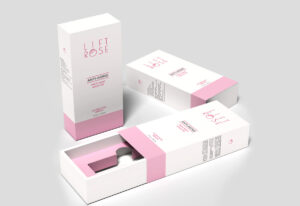
As the global beauty industry continues to grow, so does its environmental impact. Cosmetic packaging, in particular, is a major contributor to waste, with many products packaged in single-use plastic that takes centuries to decompose. However, with growing awareness around sustainability and a shift towards eco-conscious consumerism, the beauty industry has begun to make strides in adopting more sustainable practices. In this article, we’ll explore how sustainable practices are shaping the future of cosmetic packaging wholesale and the benefits these changes bring to both the industry and the environment.
1. The Environmental Impact of Traditional Cosmetic Packaging
Traditional cosmetic packaging is often made from materials like plastic, glass, and aluminum, many of which are not recyclable or are difficult to recycle. Plastic is especially problematic, as it takes hundreds of years to break down in landfills and is a significant source of ocean pollution.
Many cosmetic brands use excessive plastic packaging, especially for products like skincare creams, shampoos, and makeup. The single-use nature of this packaging contributes to the growing problem of plastic waste. As a result, the beauty industry has been under increasing pressure to find sustainable alternatives to reduce its environmental footprint.
Key environmental issues:
- Excessive Plastic Waste: Cosmetics, particularly in the form of plastic tubes, containers, and caps, contribute significantly to the overall plastic waste problem.
- Non-Recyclable Materials: A lot of cosmetic packaging is made from mixed materials, making recycling challenging.
- High Carbon Footprint: The production and transportation of cosmetic packaging materials contribute to carbon emissions.
2. Rise of Sustainable Cosmetic Packaging
In response to these environmental concerns, many cosmetic companies have begun shifting towards sustainable packaging solutions. This transition focuses on reducing waste, using eco-friendly materials, and implementing more efficient manufacturing processes.
Popular Sustainable Packaging Trends:
- Biodegradable Packaging: Materials such as cornstarch, mushroom-based packaging, and paper made from bamboo or sugarcane are gaining popularity. These materials break down naturally and are often compostable, making them a more sustainable choice compared to traditional plastics.
- Recyclable Materials: Brands are increasingly opting for recyclable packaging, such as PET (Polyethylene Terephthalate) plastic, glass, or aluminum. These materials are easier to recycle and reduce the amount of plastic waste in landfills.
- Refillable Packaging: Some beauty brands are offering refillable containers for their products, encouraging consumers to reuse the same packaging. This reduces the overall volume of packaging waste produced over time.
- Minimalist Packaging: Streamlined, minimalist packaging reduces the amount of material used without sacrificing design or functionality. This approach minimizes waste and lowers production costs.

The Benefits of Sustainable Cosmetic Packaging:
- Reduction in Environmental Footprint: Sustainable packaging reduces the need for non-renewable resources and lowers the overall waste created by the industry.
- Improved Recycling Rates: Using recyclable materials and encouraging refills improves the chances of packaging being reused or recycled, rather than ending up in landfills.
- Eco-Friendly Consumer Appeal: As consumers become more eco-conscious, brands that embrace sustainable practices can differentiate themselves in the market. Many beauty shoppers are willing to pay a premium for products that are environmentally friendly and ethically produced.
3. The Role of Consumers in Promoting Sustainable Packaging
While cosmetic brands play a crucial role in adopting sustainable packaging practices, consumers also have an important role to play. The increasing demand for environmentally conscious products is driving many brands to innovate and implement greener packaging solutions.
Consumers are not only looking for products that are good for their skin but also for packaging that reflects their values. This shift in consumer behavior has created a competitive market for sustainable packaging, with brands racing to meet the demand for eco-friendly alternatives.
How Consumers Are Impacting Change:
- Supporting Sustainable Brands: More consumers are choosing beauty products from brands that prioritize sustainability in their packaging. This includes products that use refillable containers, biodegradable packing materials, or recycled content.
- Demand for Transparency: Consumers are increasingly seeking transparency from brands about the sourcing, production, and recyclability of their packaging. Many are also looking for certifications, such as FSC (Forest Stewardship Council) or Cradle to Cradle, that ensure the packaging meets certain environmental standards.
- Encouraging Brands to Do More: Social media campaigns, petitions, and consumer feedback are pressuring beauty companies to adopt more sustainable practices. This grassroots movement has forced many established brands to reevaluate their packaging and embrace greener solutions.
4. Challenges in Transitioning to Sustainable Packaging
Despite the clear benefits of sustainable packaging, there are several challenges that cosmetic brands must overcome in the transition process. Sustainability is not a one-size-fits-all solution, and there are complexities involved in selecting and using eco-friendly materials that still meet the practical needs of packaging.
Common Challenges:
- Cost Considerations: Sustainable packaging materials can be more expensive to source and produce than traditional plastic or glass. For smaller brands or startups, the cost can be prohibitive, making it difficult to implement sustainable packaging practices.
- Quality and Durability: Sustainable materials must meet the same performance standards as conventional materials. Some eco-friendly packaging options may not be as durable, particularly in extreme conditions like heat or moisture, which can affect the product’s quality and safety.
Conclusion:
The shift towards sustainable cosmetic packaging is a significant step toward reducing the beauty industry’s environmental impact. By adopting eco-friendly materials, reducing waste, and encouraging recycling and refills, cosmetic brands can help preserve the planet for future generations. However, achieving widespread change will require collaboration between brands, consumers, and suppliers to address the challenges and create more sustainable solutions.
Read the latest blogs here



